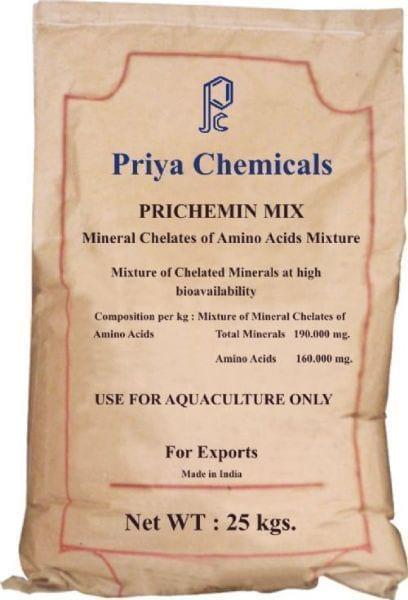Explore all the information on
Aquaculture health
Welcome to the page about Aquaculture health of Engormix; a source of knowledge on Aquaculture health.
Álvaro Rodríguez, Manager Director for Aquaculture for Liptosa, talks about the company's participation at Eurotier 2016 and the line of products they offer to the Aquaculture market.
...
Comments : 0
Recommendations: 4
the aquaculture industry has developed significantly over recent decades and is, today, one of the fastest-growing food production sectors in the world. One of the most important problems that affect aquaculture is the appearance of infectious diseases. Among bacterial diseases affecting cultured salmonid fish, Bacterial Cold-Water Disease, caused by Flavobacterium psychrophilum, produces high mortality and morbidity and consequently, economical losses...
Comments : 0
Recommendations: 0


PRICHEMIN MIX
Priya's PRICHEMIN MIX is a mineral supplement for aquaculture. It consists of a mix of mineral chelats from aminoacids
Suggested link
An increased palatability of feed when coated with a specific probiotic was discovered in this trial. The marine shrimp, having poor sight, need to recognise their environment by other senses, i.e. tactile, gustatory and olfactory. The olfactory sense is important because it will dictate whether a shrimp is attracted to an artificial feed. As a consequence, commercial feed manufacturers formulate their feed for their...
Comments : 2
Recommendations: 0
Aquaculture is concerned with 'the propagation and rearing of aquatic organisms under complete human control involving manipulation of atleast one stage of an aquatic organism's life before harvest, in order to increase its production'. Fish catches from the marine environment have been steadily declining in many parts of the world due to over-exploitation and pollution, making many people turning to aquaculture to improve the food production and to contribute for economic development....
Comments : 6
Recommendations: 0


PRICHEMIN MIX
Priya's PRICHEMIN MIX is a mineral supplement for aquaculture. It consists of a mix of mineral chelats from aminoacids
Suggested link
The ongoing outbreak of early mortality syndrome/acute hepatopancreatic necrosis (EMS/AHPN) has had dramatic impacts on shrimp producers in affected countries in Asia and Mexico. Following reports of the disease being associated with broodstock management – for example, through the use of contaminated polychaetes – there has been a renewed focus on larval quality. Investing in quality larvae fits well in the holistic...
Comments : 0
Recommendations: 0
A product used as a disinfectant in agriculture, food preparation, and medical facilities also kills a fungus that causes the disease saprolegniasis on catfish eggs, and it has the potential to treat harmful parasites. At the Agricultural Research Service’s Harry K. Dupree Stuttgart...
Comments : 2
Recommendations: 0


PRICHEMIN MIX
Priya's PRICHEMIN MIX is a mineral supplement for aquaculture. It consists of a mix of mineral chelats from aminoacids
Suggested link
How to prevent pesticide toxicity in tilapia? ...
Comments : 3
Recommendations: 0
New Tilapia fry are sick. Water quality is good. ph 8, DO 6.5, ammonia .01, nitrite .25, nitrate 10. ...
Comments : 0
Recommendations: 0


PRICHEMIN MIX
Priya's PRICHEMIN MIX is a mineral supplement for aquaculture. It consists of a mix of mineral chelats from aminoacids
Suggested link
Materials and methods Test site The trial was conducted during July–September 2011 (winter season), in a commercial fish farm, 30 kilometers to the East of Puerto Montt, X Region of Chile. Fishes Fishes of local stock rainbow trout of 4 g of average weight, spawning in late April were used for the...
Comments : 0
Recommendations: 0
Dr. Enric Gisbert from the IRTA Sant Carles de la Rapita speaks about the use of Feed Additives For Fish Health And Welfare at the Sponsor Day: Seminar on animal Feeding, May 2014. ...
Comments : 1
Recommendations: 1


PRICHEMIN MIX
Priya's PRICHEMIN MIX is a mineral supplement for aquaculture. It consists of a mix of mineral chelats from aminoacids
Suggested link
Understanding the microbial ecological process in ponds and in the shrimp intestinal tract is vital to maintain and optimize productivity without prophylactic use of hazardous substances. The maintenance of good water quality and the control of disease are closely linked to managing the communities of microbes and phytoplankton. ...
Comments : 0
Recommendations: 0
In a presentation during a session on marine fish and larval rearing innovation, at the Australasian Aquaculture 2008, Brisbane we discussed that Bacillus probiotics are proving very beneficial for fish larval rearing in European and Asian hatcheries, The strains of Bacillus were checked for safety and selected for their ability to inhibit directly bacteria pathogenic to fish, produce exoenzymes to improve digestion and degrade waste products and to grow under a...
Comments : 0
Recommendations: 0


PRICHEMIN MIX
Priya's PRICHEMIN MIX is a mineral supplement for aquaculture. It consists of a mix of mineral chelats from aminoacids
Suggested link
World tilapia production has risen from 830,000 tonnes in 1990 to 1.6 million tonnes in 1999 and again to 2.5 million tonnes in 2005 (Josupeit, 2007). China is the world's largest producer of the tilapia, producing over one million tonnes in 2005, followed by Egypt (300,000 tonnes), Indonesia, Philippines (200,000 tonnes each) and Thailand (100,000 tonnes). By 2010, world tilapia production is expected to reach 3.5 million tonnes (Josupeit, 2007). Risks from diseases With...
Comments : 1
Recommendations: 0
This article was originally published on the North American Journal of Aquaculture 74:438–442, 2012 American Fisheries Society 2012 ISSN: 1522-2055 print / 1548-8454 online DOI: 10.1080/15222055.2012.676020 Summary The San Pedro (also known as the Pacific beakfish) Oplegnathus insignis is a species of perciform fish found in the eastern Pacific Ocean. In northern Chile, San Pedro are an important food fish currently...
Comments : 0
Recommendations: 0


PRICHEMIN MIX
Priya's PRICHEMIN MIX is a mineral supplement for aquaculture. It consists of a mix of mineral chelats from aminoacids
Suggested link
1 Departments of Otolaryngology, Charles Drew University of Medicine and Science, 1621 East, 120th Street, Los Angeles, California 90059 2 Department of Zoology, Faculty of Science, University of Mansoura, Mansoura 35516, Egypt 3 National Institute of Oceanography and Fisheries, 101 Kaser El Aini Street, Cairo, Egypt 4 Internal Medicine, Charles Drew University of Medicine and Science, 1731 E....
Comments : 0
Recommendations: 0
From both nutritionist and aquaculturist points of view, our aim is to sustainably produce aquatic food with superior sensory properties and high cardioprotective properties. The reason is that although preventable, cardiovascular diseases (CVDs) remain the top global cause of death and stroke. The prevention of atherosclerosis is, therefore, a major objective of modern medical and biochemical investigations into the...
Comments : 0
Recommendations: 0


PRICHEMIN MIX
Priya's PRICHEMIN MIX is a mineral supplement for aquaculture. It consists of a mix of mineral chelats from aminoacids
Suggested link
INTRODUCTION Today it is generally accepted that the three major routes of infection in fish are through: a) skin, b) gills and c) the gastrointestinal (GI) tract. The GI microbiota, including lactic acid bacteria (LAB), have been suggested to be important in fish health and it has been suggested that the autochthonous gut bacterial community may be responsible for controlling the colonization of...
Comments : 0
Recommendations: 0
INTRODUCTION Hormones, antibiotics, ionophers and some salts compounds have been used as growth promoters and to some extent to prevent diseases. However, their inadequate applications show a negative effect on aquaculture production and environment (Góngora, 1998). Functional additive, like probiotics, is a new concept on aquaculture (Li and Gatlin III, 2004) where the additions of microorganisms on diets show a...
Comments : 0
Recommendations: 0


PRICHEMIN MIX
Priya's PRICHEMIN MIX is a mineral supplement for aquaculture. It consists of a mix of mineral chelats from aminoacids
Suggested link
Introduction Egyptian aquaculture represents a unique model of cohabitating freshwater fishes that live together in confined space permitting continuous interaction between different aquatic species and their environment. Polyculture system currently adopted by the Egyptian earthen pond aquaculture has increased the potential of transspecies infections with different pathogens spatially...
Comments : 6
Recommendations: 1
MSD Animal Health, which is known as Merck Animal Health in North America, has obtained approval from Indonesian authorities to begin marketing an inactivated vaccine that aids in the protection against Streptococcus agalactiae infections in tilapia. AQUAVAC Strep Sa, the world’s first oil-adjuvanted vaccine for tilapia, is administered intraperitonealy as a single-injection dose to fish weighing no less than 15 grams. Vaccinated fish develop...
Comments : 0
Recommendations: 0










